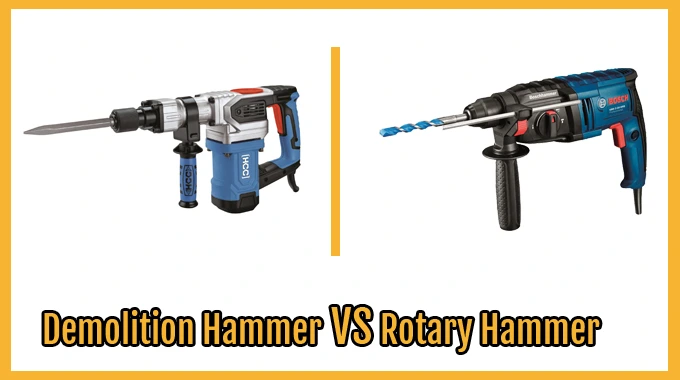Last Updated on July 31, 2023
When it comes to demolition hammers vs rotary hammers, there are a few key differences to consider. Demolition hammers are typically heavier and more powerful, making them ideal for breaking through concrete or stone.
Rotary hammers are lighter than demolition hammers and offer more precise control. They’re perfect for drilling holes into complex objects. So, when deciding between a demolition hammer and a rotary hammer, it’s paramount to consider the task at hand.
With the help of this article, we’ll break down the key differences between demolition and rotary hammers to help you make an informed decision. Without further ado, let’s get started with the process right away.
Definition of Demolition Hammer in Depth
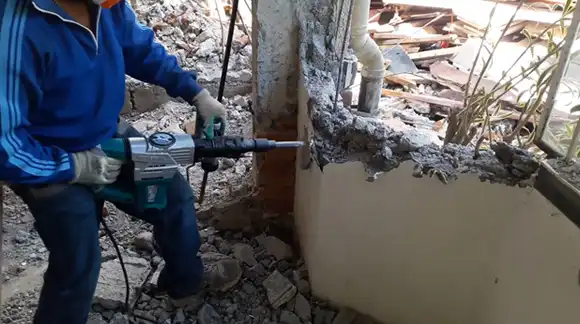
A demolition hammer is a tool used to break up concrete, asphalt, or other materials. It typically has a chisel-shaped point that is attached to a long handle. The handle is usually made of metal, and the head of the hammer is usually made of steel.
The Hammerhead is the part of the demolition hammer that delivers the impact force. The weight of the head, combined with the length of the handle, provides leverage that helps to increase the impact force.
The power of the demolition hammer is determined by its weight, design, and construction. For example, a heavier hammer will typically have more power than a lighter one.
Hammers that are designed for breaking up concrete will usually be more powerful than those designed for breaking up asphalt. Even a relatively light demolition hammer can be powerful enough to cause serious property harm or injure someone if it is not used correctly.
Definition of Rotary Hammer in Detail
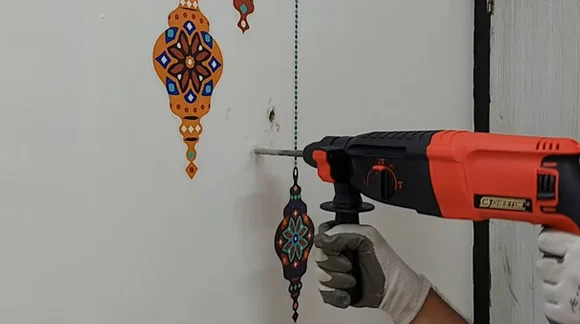
A rotary hammer is a type of power tool that uses a rotating drill bit to create holes in concrete, stone, or other hard materials. The drill bit is attached to a piston, which rapidly rotates the bit while also pounding it back and forth against the material. This combination of rotation and impact creates a powerful drilling action that can quickly create large holes.
Construction workers often use rotary hammers to create holes for anchors or to drill through tough materials like brick or concrete. Homeowners can also use them for tasks like boring holes for new doorknobs or hanging pictures. No matter the application, a rotary hammer can save you a lot of time and effort compared to traditional hand-held drills.
Recommended Article To Read: Which Drywall Mud Fills Anchor Holes Easiest?
How Do They Differ: Demolition Hammer vs Rotary Hammer
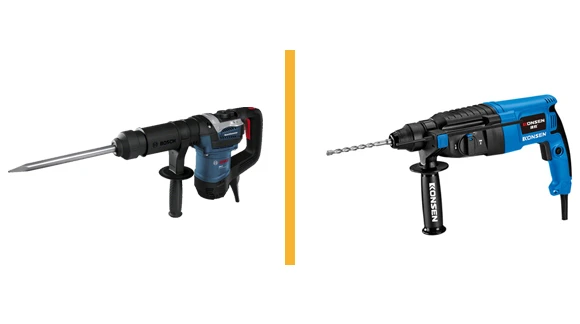
There are some pros and cons to both of these hammers, and we will discuss them in this section:
Demolition Hammer Pros
Here are some pros of Demolition Hammer:
Projects Such As Tearing Down Walls
A demolition hammer is a powerful tool that can be used to break down walls and remove tiles. Its versatility makes it perfect for a variety of demolition projects. The hammer is designed to deliver a high amount of force, making it easy to break through materials like concrete and brick.
The long handle provides leverage, allowing you to apply maximum force to the material you’re trying to break.
The demolition hammer is also equipped with a chisel head, which can be used to remove tiles without damaging the underlying surface. When choosing a demolition hammer, selecting one that is appropriate for the size and scope of your project is essential.
Smaller hammers are perfect for breaking through drywall or removing smaller tiles, while more giant hammers are better suited for breaking down walls or removing large tiles. No matter what your project entails, a demolition hammer can make quick work of it.
Available in Electric and Pneumatic
They are offered in electric and pneumatic versions, and each has its advantages and disadvantages. Electric demolition hammers are typically more powerful than pneumatic ones, making them ideal for larger projects. They are also much heavier and more challenging to handle.
Pneumatic demolition hammers require less effort to maneuver. They are also less expensive than electric models. Pneumatic hammers produce less vibration, making them more comfortable to use. Ultimately, the best choice of demolition hammer depends on the specific needs of the project at hand.
Relatively Easy to Use
Many believe that demolition hammers are difficult to use and require a great deal of strength. This is not the case. While it is true that demolition hammers can be very powerful, they are also relatively easy to use. With a little practice, most people can learn to use a demolition hammer effectively. The key is to start with small, manageable projects and work your way up.
As you gain experience, you will be able to take on larger and more challenging tasks. You don’t need to be particularly strong to operate a demolition hammer. The weight of the tool does most of the work, so as long as you can hold it steady, it will get the job done.
Professional and DIY Tool
While professional contractors commonly use demolition hammers, DIY enthusiasts can also find several uses. For example, demolition hammers can be used to remove old tile flooring or to demolish an old shed.
They can also be used to break up large pieces of concrete for a home improvement project. Many models come with user-friendly features such as vibration dampening and ergonomic handles. They are an excellent tool for both professionals and DIY enthusiasts alike.
Demolition Hammer Cons
It is essential to be aware of some of the cons of this tool:
Incredibly Loud Sound
This tool can be extremely loud, and the noise generated by these devices can travel long distances. The sound of a demolition hammer can be heard from far away. This can be especially problematic for people who live near construction sites or other areas where these devices are regularly used.
The noise generated by demolition hammers can also be harmful to your hearing. If you are exposed to this type of noise regularly, it is vital to take steps to protect your ears. Wearing earplugs or earmuffs can help to reduce your exposure to this potentially harmful noise.
Produce Lots of Dust
hammers can produce a lot of dust and debris, which can get messy and dangerous. To minimize the risk of inhaling dust and debris, it is crucial to use the proper safety equipment. A respirator or dust mask will help to protect your lungs, and goggles can shield your eyes.
It is also essential to wear protective clothing, such as gloves and a long-sleeved shirt. It is vital to work in a well-ventilated area to allow the dust and debris to dissipate quickly. By taking these precautions, you can help to ensure that your demolition project is safe and clean.
Improper Use can be Harmful
When using a demolition hammer, it is crucial to be aware of the potential hazards to the surrounding walls, floors, and ceilings. If the tool is not used correctly, the vibrations can cause cracks or even break through the material. The force of the hammer can easily dislodge tiles or other materials from the surface, potentially causing injury.
For these reasons, it is essential to use caution when operating a demolition hammer and to make sure that any loose materials are removed from the area before beginning work. With proper care and attention, a demolition hammer can be a powerful tool for safely removing obstacles in your path.
Expenses are High
They can be expensive to buy and maintain. The most significant expense is the cost of the replacement chisels. Over time, the chisels wear down and need to be replaced. The hammer itself needs to be regularly serviced and maintained.
The cost of doing this can add up over time, making demolition hammers a significant expense for construction companies. It may be more cost-effective to rent a demolition hammer rather than purchase one outright. This can help to save on maintenance and replacement costs over time.
Rotary Hammer Pros
Here are some of the benefits of using a rotary hammer:
Impactful than Traditional Drilling
Traditional drills rely on a linear motion to create an impact, meaning that the drill bit only moves in one direction as it rotates. This can make it difficult to drill into hard materials, as the drill bit can quickly become bogged down. Rotary hammer drills use a rotary impact mechanism.
This means that the drill bit moves back and forth as it rotates, providing more power and making it easier to drill through hard materials. The rotary motion helps to clear away debris, preventing the drill bit from becoming clogged. Hammer drills are much more effective at drilling into hard materials than traditional drills.
Chisel through Thick Materials
The hammer action of a rotary Hammer also makes it possible to chisel through concrete and other thick materials. When the hammer is not in use, the head can be rotated to a chiseling position. This makes the rotary hammer ideal for breaking up concrete slabs, cutting out sections of brickwork or masonry, and removing tiles.
The chiseling action is also helpful in creating openings for doorways, windows, and pipes in walls. It can be used to drill through thick metals, such as steel plates. With the proper attachment, a rotary hammer can even be used for sanding and grinding. This versatile tool is an essential part of any builder’s toolkit.
Built-in Dust Collector
One of the most useful aspects of the rotary hammer is its built-in dust collector. This helps keep the work area clean and free of debris, which can be a hassle when working with other tools. The dust collector also helps to reduce the risk of inhalation, which is a serious health hazard when working with concrete and other dusty materials.
A dust collector can also extend the tool’s life by preventing the buildup of abrasive materials on the internal parts. This is equipped with a safety clutch that helps to protect the user from injuries in case of a jam. The rotary hammer is a safe and efficient tool that can be used for various applications.
Easily Maneuverable
One of the best features of the rotary hammer is its size. Because it is relatively lightweight and easy to maneuver, the rotary hammer is ideal for use in tight spaces. This makes it an essential tool for plumbers, electricians, and other tradespeople who often need to work in small, cramped areas.
The rotary hammer is also helpful for home DIY projects. Whether hanging a picture frame or assembling a piece of furniture, the rotary hammer can help you get the job done quickly and easily. With its many uses, a rotary hammer is an essential tool for any homeowner or contractor.
Rotary Hammer Cons
There are drawbacks associated with the use of rotary hammers, including:
Can’t Handle Big Projects
If you’re tackling a big project involving demolishing something, you’ll want to ensure you have the right tool for the job. A demolition hammer is designed to destroy large objects efficiently. It’s much more powerful than a rotary hammer and can easily handle big projects.
A rotary hammer is better suited for drilling holes into objects. It’s not as powerful as a demolition hammer and wouldn’t be able to handle a large-scale demolition project. So if you need to destroy something big, reach for a demolition hammer. It’ll make short work of the task at hand.
Unwise Use Can Cause Harm
A rotary hammer’s chisel is a significant part of the tool and can quickly become broken if it’s not treated correctly. The chisel breaks up the material you are working on, and if it becomes worn down, it can no longer do its job correctly. There are a few things that can cause trouble to the chisel, such as using it on materials that are too hard or handling it incorrectly.
If you use the chisel on hard materials, it will eventually break. Also, if you don’t use the proper techniques when using the chisel, you can destroy it. Make sure you read the instructions carefully before using a rotary hammer to avoid ruining the chisel.
Vibrations from Chiseling
When using a rotary hammer, the chiseling action can cause vibration that travels up your arm. This can be uncomfortable, and over time it can even affect the nerves or blood vessels in your arm. The vibration can cause fatigue, making it challenging to maintain a steady grip on the tool. To help reduce the risk of these problems, it is vital to use the tool properly.
Make sure you have a firm grip on the tool and keep your arm as close to your body as possible. Also, avoid overexerting yourself. Take breaks frequently so that your muscles can recover. Following these simple precautions can help minimize the risk of discomfort or injury while using a rotary hammer.
Which one is better for your needs?
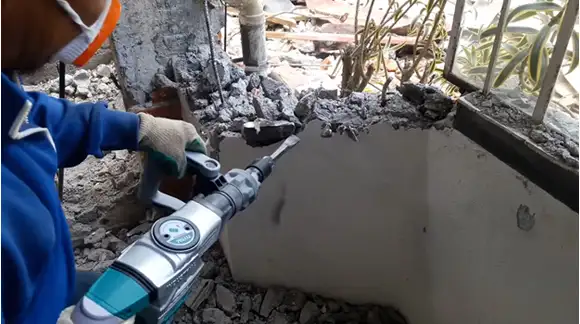
Demolition hammers are designed for heavy-duty construction projects like breaking up concrete. On the other hand, rotary hammers are better suited for smaller jobs like drilling holes in drywall. When deciding between the two, it’s essential to consider the project you’ll be working on.
When it comes to a big job that requires breaking up concrete, then a demolition hammer is the better choice. These hammers are heavier and have more power than rotary hammers, making them ideal for complex projects. They can be more challenging to control than rotary hammers, so it’s essential to use the proper technique to avoid ruining the chisel.
For smaller projects around the house, a rotary hammer will suffice. These hammers are lighter and easier to control than demolition hammers, so they are useful for drilling holes in drywall. They don’t have as much power as demolition hammers, so they might not be suitable for more significant projects.
Remember to use the appropriate procedure when using either tool in order to prevent harm to the chisel. With the right tool and care, you can complete any project, big or small.
FAQs
You might find these FAQs to be helpful if you have any questions regarding it.
Can I use a rotary hammer for demolition?
Unlike a conventional hammer, a rotary hammer has a rotating head that allows it to drill or demolish hard objects in all-day applications. When choosing a rotary hammer for demolition, it is important to select one that is powerful enough to handle the job.
Most rotary hammers have adjustable speed settings, so you can choose the setting that best suits the task. Some rotary hammers come with a chisel attachment, which can help break up larger chunks of concrete.
Can a rotary hammer drill steel?
The answer to this question depends on the type of rotary hammer drill that you have. Some rotary hammer drills are designed for softer materials, such as wood or plaster, and will not be able to drill through steel.
Other rotary hammer drills are specifically designed for drilling through more rigid materials, including concrete and steel. If you need to drill through steel, check the specifications of your rotary hammer drill before beginning your project.
Can a demolition hammer break concrete?

Most demolition hammers use a percussive action to generate the force needed to break through rigid materials. As the name suggests, this type of hammer delivers a series of quick, powerful blows that can easily shatter concrete and other hard materials.
Apart from breaking through concrete, demolition hammers can also be used to chip away at stone or brickwork, as well as chisel through metal. They are an essential tool for any construction or demolition project.
Last Words
In conclusion, we would like to thank you for reading this article. We hope that it has helped provide you with the information you need to choose between a demolition hammer and a rotary hammer.
If you consider this article helpful, please share it with your friends or family members who might also find it helpful.
You are welcome to submit questions or comments. Please feel free to leave them in the section below. We would be happy to hear from you.
